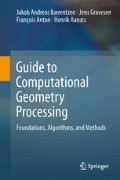Abstract
In many cases notions from differential geometry can be usefully extended to piecewise planar surfaces, and this chapter covers curvature measures on triangle meshes. A frequently used principle is to obtain a smooth surface approximation and to estimate the curvature from this approximation. Alternatively, the integral of some curvature measures can be computed from a small region of the mesh and then normalized by dividing by the area of that region.
Following these principles, we first discuss how to extend the definition of a surface normal to the edges and vertices of a triangle mesh. Next, we cover the estimation of Gaußian and mean curvature on a triangle mesh. Finally, techniques for computing the shape operator are discussed—followed by a discussion on how to obtain the principal curvatures from the shape operator.
Access this chapter
Tax calculation will be finalised at checkout
Purchases are for personal use only
Notes
- 1.
A spherical polygon is a polygon on a unit sphere: a polygon whose vertices are points on a unit sphere and whose edges are segments of great circles connecting these vertices.
References
Pinkall, U., Polthier, K.: Computing discrete minimal surfaces and their conjugates. Exp. Math. 2(1), 15–36 (1993)
Desbrun, M., Meyer, M., Schröder, P., Barr, A.H.: Implicit fairing of irregular meshes using diffusion and curvature flow. In: Proceedings of the 26th Annual Conference on Computer Graphics and Interactive Techniques, SIGGRAPH ’99, pp. 317–324. ACM Press, New York (1999). doi:10.1145/311535.311576
Thürmer, G., Wüthrich, C.A.: Computing vertex normals from polygonal facets. J. Graph. Tools 3(1), 43–46 (1998)
Bærentzen, J., Aanæs, H.: Signed distance computation using the angle weighted pseudo-normal. IEEE Trans. Vis. Comput. Graph. 11(3), 243–253 (2005)
do Carmo, M.P.: Differential Geometry of Curves and Surfaces. Prentice-Hall, Englewood Cliffs (1976)
Meyer, M., Desbrun, M., Schröder, P., Barr, A.H.: Discrete differential-geometry operators for triangulated 2-manifolds. In: Hege, H.-C., Polthier, K. (eds.) Visualization and Mathematics III, pp. 35–57. Springer, Heidelberg (2003)
Cohen-Steiner, D., Morvan, J.-M.: Restricted Delaunay triangulations and normal cycle. In: Proceedings of the Nineteenth Annual Symposium on Computational Geometry, SCG ’03, pp. 312–321. ACM Press, New York (2003). doi:10.1145/777792.777839
Hildebrandt, K., Polthier, K.: Anisotropic filtering of non-linear surface features. Comput. Graph. Forum 23(3), 391–400 (2004)
Golub, G.H., van Loan, C.F.: Matrix Computations, 3rd edn. John Hopkins, Baltimore (1996)
Hamann, B.: Curvature approximation for triangulated surfaces. In: Geometric Modelling, pp. 139–153. Springer, London (1993)
Surazhsky, T., Magid, E., Soldea, O., Elber, G., Rivlin, E.: A comparison of Gaussian and mean curvatures triangular meshes. In: Proceedings of IEEE International Automation (ICRA2003), Taipei, Taiwan, 14–19 September, pp. 1021–1026 (2003)
Taubin, G.: Estimating the tensor of curvature of a surface from a polyhedral approximation. In: Proceedings of the Fifth International Conference on Computer Vision, ICCV ’95, p. 902. IEEE Comput. Soc., Washington (1995)
Hertzmann, A., Zorin, D.: Illustrating smooth surfaces. In: Proceedings of the 27th Annual Conference on Computer Graphics and Interactive Techniques, SIGGRAPH ’00, pp. 517–526. ACM, New York (2000). doi:10.1145/344779.345074
Alliez, P., Cohen-Steiner, D., Devillers, O., Lévy, B., Desbrun, M.: Anisotropic polygonal remeshing. ACM Trans. Graph. 22(3), 485–493 (2003). doi:10.1145/882262.882296
Kälberer, F., Nieser, M., Polthier, K.: QuadCover-Surface Parameterization using Branched Coverings. Comput. Graph. Forum 26(3), 375–384 (2007)
Author information
Authors and Affiliations
Corresponding author
Appendix
Appendix
In this appendix, we derive the Cotan formula for the gradient of the area of a triangle. Given a triangle (shown in Fig. 8.9) whose vertex p i is movable, compute the gradient of the area of the triangle as a function of p i .
It is clear that the gradient is perpendicular to the plane of the triangle since moving p i either in the positive or negative direction along the triangle normal will increase the area. Hence, the present position is a minimum. Moving p i parallel to the base line b will not change the area. It follows that the gradient is in the plane of the triangle and orthogonal to b. It is trivial to find the length of the gradient, and this leads to the first line of the equation below. After a number of steps, we reach the expression used in (8.4).
Some of the steps may be a little tricky. The bottom line is that we need to use the fact that the cotangent of an angle between two vectors a and b is equal to \(\frac{\mathbf {a}^{T} \mathbf {b}}{\|\mathbf {a} \times \mathbf {b}\|}\):
Rights and permissions
Copyright information
© 2012 Springer-Verlag London
About this chapter
Cite this chapter
Bærentzen, J.A., Gravesen, J., Anton, F., Aanæs, H. (2012). Curvature in Triangle Meshes. In: Guide to Computational Geometry Processing. Springer, London. https://doi.org/10.1007/978-1-4471-4075-7_8
Download citation
DOI: https://doi.org/10.1007/978-1-4471-4075-7_8
Publisher Name: Springer, London
Print ISBN: 978-1-4471-4074-0
Online ISBN: 978-1-4471-4075-7
eBook Packages: Computer ScienceComputer Science (R0)


